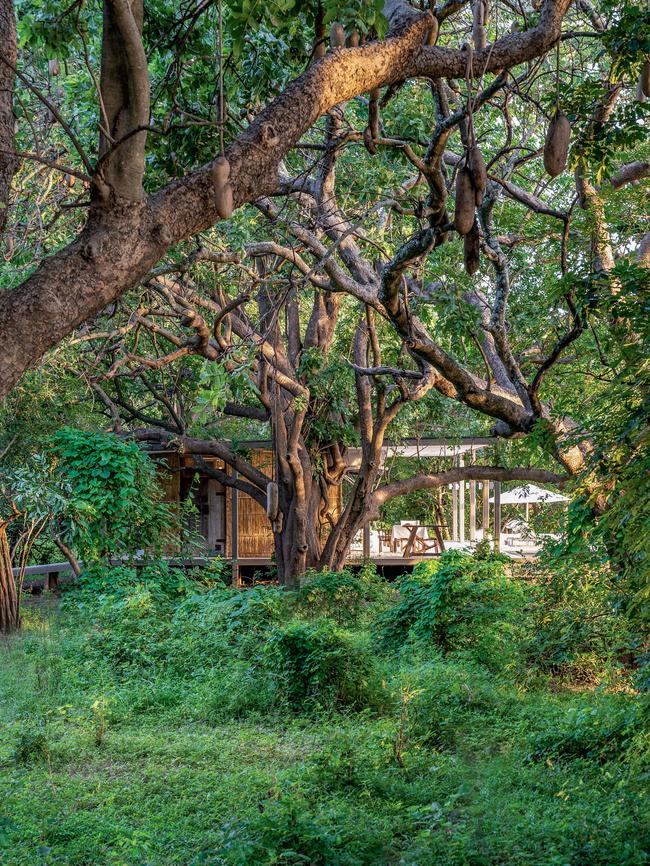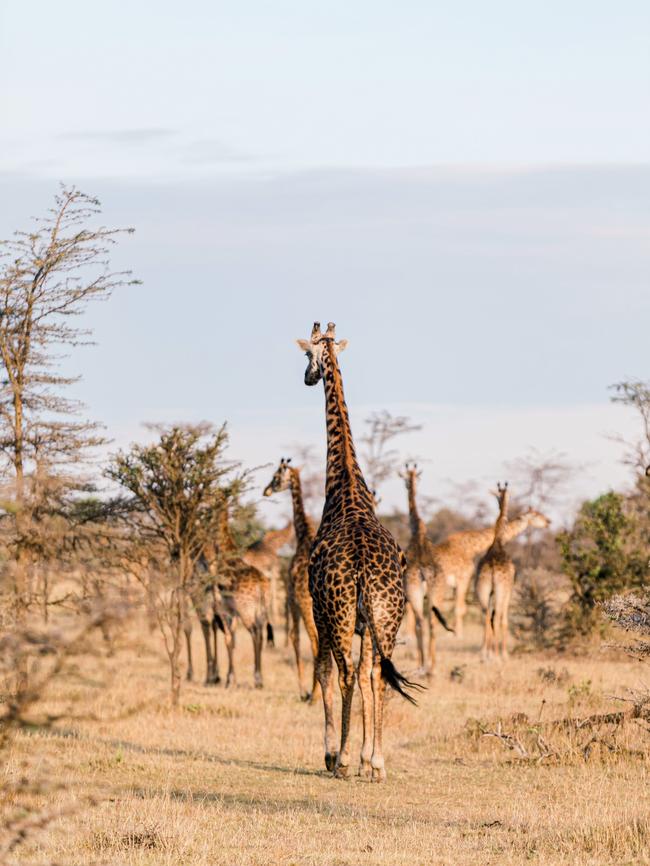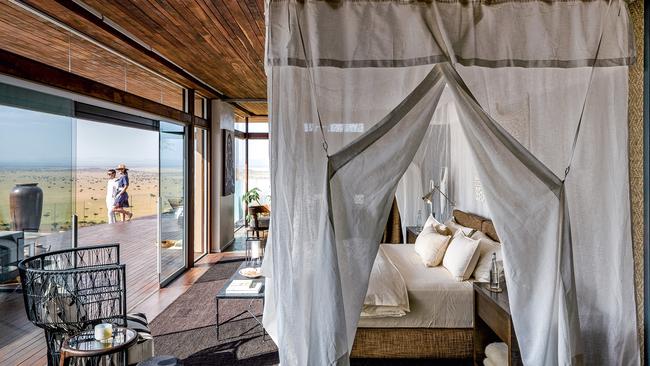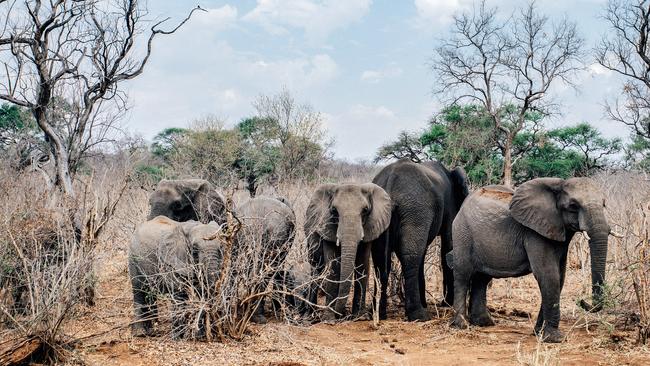Into the wild: best sustainable safaris
After two years of lacklustre living, what better way to reawaken your senses than to pay your respects to precious wilderness while contributing to their survival?

Catch the drift with slow, sustainable travel in the latest edition of Travel + Luxury, available to digital subscribers now.
Done well, a safari is a slow, immersive journey, a surrender to nature. It is also a search for common truths – hard, wild, illuminating truths about life and death and one’s grain-of-sand-like place in the world. Combine this humbling experience with a level of luxury that imbues every waking moment with a sense of awe, and it really can be the trip of a lifetime.
But a safari can be so much more, even, than this. It can support the regeneration of nature, seek to right some of the wrongs we humans have wrought. It can contribute to the empowerment of local communities, investment in local enterprise, and the integration of deep cultural knowledge and skills into various business and conservation models.
Julie McIntosh, founder and director of The Classic Safari Company, says “most people come away from a safari with a fundamental shift in their world view. Clients instantly understand the need for tourism and the role it plays in protecting the communities, the wilderness and the wildlife.”
From golden savanna to lush, life-affirming delta, romantic tented luxury to cutting-edge innovation in eco-architecture, the lodges detailed here vary greatly, but share an unwavering passion for protecting and nurturing their patch of this fragile world. They all strive to be better, to make this Earth better, to make the safari experience better. And we are all better for it.
1. Grootbos Private Nature Reserve, South Africa
Grootbos offers a different, extraordinarily beautiful kind of safari – from the Marine Big Five to magical carpets of native flowers (this 2,500-hectare Eden of biodiversity is part of South Africa’s Cape Floral Kingdom). Here, dynamo owner Michael Lutzeyer has created a serene sanctuary where guests can completely immerse themselves in the environment: ancient, twisting milkwood forests, startling swathes of pinker-than-pink Erica irregularis fynbos, and spectacular stretches of churning coastline teeming with ocean life. Certified as carbon-negative since 2018, Grootbos runs a highly accountable foundation with an impressive suite of initiatives – from opening a classroom in the local community during Covid restrictions to a Green Futures education program, a football foundation, and a fledgling botanical art gallery detailing the reserve’s plant species (almost 900 and counting). A candlelit wine cellar starring excellent Overberg pinot noirs, hyper-local menus boasting foundation farm produce, and baths with dreamlike views make this the quietly majestic escape we’ve been crying out for.


2. Time + Tide Chinzombo, Zambia
Follow in the footsteps of British conservationist Norman Carr, pioneer of the walking safari, at this intimate camp on the banks of the Luangwa River. The pared-back aesthetic, vintage accents and lush textures (buttery leather, timber and river reeds, and cool, raw linens) highlight the Jungle Book, wildlife-rich setting right outside the tents – accessed by simply rolling up the canvas and stepping out to your private pool. Embark on a boat safari, or open your eyes (and mind) on a walking safari with highly experienced guides who share insights into the local tribes playing a key role in conservation. The Time + Tide Foundation carries on Carr’s revolutionary vision from the 1950s, when he established Zambia’s first game-viewing camp in co-operation with Paramount Chief Nsefu of the Kunda tribes. Efforts today include supporting women in their business endeavours, educating girls, helping promising students to reach boarding school or university, and, of course, protecting Zambia’s abundant wildlife.
3. Cottar’s 1920s Camp, Kenya
Calvin Cottar started guiding aged just 15; today, he’s the owner of Cottar’s Safaris, positioning the fifth-generation family business for a sustainable future. Cottar and partner Louise created Cottar’s Wildlife Conservancy Trust, leasing the land from Maasai owners in a pioneering conservation model that empowers communities to manage the preservation of their land for economic and ecological benefit. The trust provides funding for schools, medical services and more; the collaborative endgame is to preserve a vital regional wildlife corridor, and reduce human-wildlife conflict. The camp itself – gorgeously refurbished during lockdowns – taps into the romantic, adventurous spirit of classic Kenyan safaris (think canvas safari baths, and afternoon teas served from original travelling trunks). The Mess Tent houses first-edition Africana books, a fireside library nook, and historical safari photography. Evening talks cover wide-ranging topics, and new “safari impact experiences” include vulture rehabilitation, meeting an all-female conservation ranger unit, and participating in reforestation seed dispersal bushwalks.

4. Miavana by Time + Tide, Madagascar
It may look heaven-sent, but Miavana by Time + Tide is all about celebrating its spectacularly unique place right here on Earth (around 80 per cent of Madagascar’s wildlife can’t be found anywhere else). The private island is the jumping-off point to explore the surrounding tropical archipelago wilderness: adventure-seekers can try paddle-boarding to deserted coves to watch turtles laying eggs; wreck-diving and exploring the pristine reef; lemur-trekking; chameleon encounters, and orchid hunting. Laid-back types can soak up the ambience of the sprawling, sea breeze-strewn villas with their hand-cut stone walls and hand-dyed textiles dipped in aquatic hues. Ask your personal butler to arrange guided stargazing, or browse an eclectic assortment of Madagascan treasures including a butterfly collection, an extinct elephant bird egg, and a pygmy hippo skeleton. The four-year build involved the planting of more than 100,000 indigenous trees, and an on-site conservation team oversees a lemur protection program, reforestation and sustainable fishing practices. It’s the stuff
of hedonistic castaway dreams with an eco-conscience.

5. Singita Sasakwa Lodge, Tanzania
Singita tends to make lifelong guests out of first-time visitors. The conservation and luxury eco-tourism brand’s attention to detail is extraordinary – its impact is meaningful and measurable, its hospitality, excellent. Sasakwa’s refreshed, Edwardian manor-styled elegance (the yawning verandas were made for sunset G & Ts), vast Serengeti vistas and extensive conservation efforts beautifully showcase Singita’s mission to preserve expansive swathes of wilderness for future generations. Here, says McIntosh, “The communities within have learnt how to coexist with the wildlife and are part of the solution in protecting it all.” It’s classic Singita: forging partnerships with local people, making a genuine commitment to their longevity. Its partnership with the Grumeti Fund has transformed depleted wildlife populations (buffalo, wildebeest, elephants), including the 2019 relocation of nine eastern black rhinos. The annual Serengeti Girls Run raises funds for the empowerment of girls, and a new carbon levy is added to every guest booking and invested in accredited projects to offset emissions.

6. Bisate, Rwanda
Bisate’s bold, beautiful design and heart-stopping mountain gorilla sightings grab the limelight, but this stunning sustainable wonderland is carefully underpinned by a deep commitment to its land and people. The highly sensitive construction process (materials were carried in by hand to avoid causing environmental damage) created an exceptionally light footprint for the sinuous thatched villas perched among verdant surrounds on the edge of Volcanoes National Park. Reforesting efforts – aimed at expanding the habitat for Rwanda’s endangered mountain gorillas – continue apace, with around 60,000 indigenous trees nurtured into complete independence to date. In June 2021, for the first time since Bisate opened, a silverback mountain gorilla was spotted exploring the property – a thrilling sign the reforestation is working. Guest stays contribute to a Sustainability Fund to support community, education and conservation projects; and donor-sponsored Covid-relief food parcels distributed locally and further afield have benefited more than 1,200 families. Bisate also operates a “war on waste” strategy and practises permaculture in the abundant on-site gardens.
7. Mombo, Botswana
This deeply handsome camp, nestled among giant mangosteen and fig trees in the famed Moremi Game Reserve, plays a key conservation role in Botswana – from rhino relocations to an accredited in-house staff training school. Classic safari style meets modern luxe at Mombo, with expansive suites featuring vintage leathers, copper-clad fireplaces, hand-embroidered cushions, and wooden and brass chandeliers – all anchored in delta tones of earth and grass, sand and wood. A tree expert was employed during the 2017 rebuild to ensure the camp’s existing footprint wasn’t expanded in a way that harmed surrounding vegetation. Mombo is also 100 per cent solar-powered, carefully manages wastewater and prepares waste for recycling on-site. Private plunge pools and swing beds overlooking the game-rich flood plains are the perfect spot for idling after an exhilarating game drive, during which you’ll have spied the likes of leopards, spotted hyenas, elephants, giraffes, Burchell’s zebras, and perhaps cheetahs or rare rhinos.

8. Matetsi Victoria Falls, Zimbabwe
Matetsi shows the impact one, discerning, family-owned operation can have on the surrounding land, wildlife and community. The lodge’s elegant, elemental design beautifully showcases Zimbabwean craftsmanship, and provides the perfect base from which to explore Victoria Falls and the reserve’s resurgent wilderness. Days start with coffee by your private plunge pool on the banks of the mighty Zambezi, and segue into a choose-your-own-adventure experience (personal butler included; helicopter adventures optional). Six years of intensive efforts, including the rewilding of the private game reserve, have yielded the re-establishment of a clear-roads network for game viewing and anti-poaching surveillance, and solar-powered boreholes create waterholes for wildlife including buffalo, elephants, wildebeest, lions and zebra. Matetsi also partners with Pack for a Purpose: guests can bring supplies like toys, first-aid kits, and baby goods to be distributed to those in need (for example, GoGo packs for grandmothers looking after orphaned children).

9. Omaanda, Namibia
The stars aligned to create this remarkable wildlife sanctuary and serene bolthole in the Namibian savanna. An auspicious encounter between Angelina Jolie and the CEO of Zannier Hotels, Arnaud Zannier, at his Cambodian outpost introduced the hotelier to the conservation efforts of Rudie and Marlice van Vuuren, leading him to join forces with the dynamic duo. The result? A 9,000-hectare reserve, home to antelopes, leopards, giraffes, warthogs, ostriches, baboons and jackals, and the Shiloh Wildlife Sanctuary, which cares for injured animals including endangered rhinos, and reintegrates them into the vast surrounds. Omaanda’s achingly beautiful thatched huts were designed by Namibian architects and crafted by local workers in the style of traditional Owambo architecture: all rounded walls and textured, desert-sand colours, with open fireplaces and panoramic terraces. A sleek swimming pool and tiny, chic open-air bar offer
star-spangled vistas alongside cocktails. The staff are 95 per cent Namibian, and guides collaborate with San tribespeople to share intimate knowledge of the area.
10. Tswalu, South Africa
In Setswana, Tswalu means “new beginning” and the rugged southern Kalahari is being thoughtfully revitalised under what McIntosh calls a “grand vision for conservation and sustainability in a unique environment”. This haven for endangered and rare animals – including desert black rhinos, pangolins, Kalahari black-maned lions – is also a pioneering research hub. The Kalahari Endangered Ecosystem Project (KEEP) explores the cascading effects of climate change on this complex ecosystem; and guests can participate in efforts to repair the extensive damage caused by farming. Restaurant Klein Jan offers a remarkable taste of the Kalahari. Michelin-starred chef Jan Hendrik van der Westhuizen painstakingly researched local ingredients and culinary traditions, ingeniously adapted to water scarcity and tough growing conditions. Diners enjoy several courses, served across evocative locations in what looks like a traditional farmhouse (spoiler: it’s not), housing a stunning subterranean “root cellar” with bounty such as goat’s milk cheeses, grains, pistachios, dates, tsamma melons and dry-aged beef.
Follow @travelandluxury on Instagram for travel inspiration and exclusive content.
